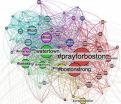(Press-News.org) Researchers at Case Western Reserve University and colleagues used "big data" analytics to predict if a patient is suffering from aggressive triple-negative breast cancer, slower-moving cancers or non-cancerous lesions with 95 percent accuracy.
If the tiny patterns they found in magnetic resonance images prove consistent in further studies, the technique may enable doctors to use an MRI scan to diagnose more aggressive cancers earlier and fast track these patients for therapy. Their work is published online in the journal Radiology at http://pubs.rsna.org/doi/full/10.1148/radiol.14131384.
The work comes just two months after senior author Anant Madabhushi and another group of researchers showed they can detect differences between persistent and treatable forms of head and neck cancers caused by exposure to human papillomavirus, with 87.5 percent accuracy. In that study, digital images were made from slides of patients' tumors.
Next up, Madabhushi's lab recently received a $534,000, 2-year grant from the Department of Defense to find the patterns of indolent versus aggressive cancer in the lungs. The goal is to diagnose the presence of aggressive lung cancers from CT scans alone.
"Literally, what we're trying to do is squeeze out the information we're not able to see just by looking at an image," said Madabhushi, a professor of biomedical engineering at Case School of Engineering and director of the Center for Computational Imaging and Personalized Diagnostics.
Searching for telltale markers
Madabhushi worked with Shannon C. Agner at Rutgers University and Mark A. Rosen, MD; Sarah Englander; Mitchell D. Schnall, MD; Michael D. Feldman, MD; Paul Zhang, MD; and Carolyn Miles; MD, at the University of Pennsylvania, on the breast cancer study.
They analyzed MR images of breast lesions from 65 women. The researchers sifted through hundreds of gigabytes of image data from each patient to try to find differences that distinguish the different subtypes of breast cancers from each other.
Madabhushi and his colleagues discovered that triple-negative cancer, benign fibroadenoma that is commonly mistaken for triple-negative, and two other common types of breast cancer—estrogen-receptor positive (ER+) and human epidermal growth factor receptor type 2-postive (HER2+)—reflect different textures when images are enhanced with contrasting agents.
The scientists mathematically modeled the textures that appear as the tissues absorb contrast-enhancing dye. The model revealed that changes over just milliseconds distinguished triple-negative from benign lesions. The investigators used machine learning and pattern recognition methods to aid in diagnoses among the three types of cancers based on texture changes and other quantitative evidence.
"Today, if a woman or her doctor finds a lump, she gets a mammogram and then a biopsy for molecular analysis, which can take two weeks or up to a month," Madabhushi said. "If we can predict the cancer is triple-negative, we can fast track the patient for biopsy and treatment. Especially in cases with triple-negative cancer, two to four weeks saved can be crucial."
For the three types of cancers, the early diagnosis would enable quick and personalized treatments. ER+ and HER2+ respond to different therapies. An MRI could also become a regular screening device for women who have family histories of these cancers.
Other cancers
Using much the same science, Madabhushi and fellow researchers from Washington University developed a way to distinguish between recurrent and treatable forms of a specific head and neck cancer called human papillomavirus-related oropharyngeal squamous cell carcinoma. That work was published earlier this year in the American Journal of Surgical Pathology. The abstract can be found at http://www.ncbi.nlm.nih.gov/pubmed/24145650.
"Most sufferers tend to have good outcomes, but a small subset—about 10 percent—doesn't," he said. "There's nothing out there to predict which.
"We developed an algorithm and found patterns that allowed us to distinguish between the two with 80 to 90 percent accuracy."
After scanning biopsy and tumor resection slides from 160 patients into a computer, the researchers found they could use nuclei of the cancerous cells to characterize and measure cell distribution and clustering patterns.
They found where the nuclei of cells had reverted to a more primitive form, a condition called anaplasia, the cells were tightly clustered and the patient suffered recurrent cancer. They graphed the nuclei in each of the images and found there was little to no overlap between the highly clustered recurrent cancer and the comparatively disperse treatable form.
The results, if confirmed through further studies, could lead to milder treatment for patients who have the non-recurrent cancer and more aggressive treatment for those with recurrent cancer, the researchers say.
"Personalized medicine is possible using this," Madabhushi said. "Using biopsy specimens, pathologists can't tell one from the other, but big data analytics can."
His lab's newest project is to find characteristics that can identify cancer or precancerous conditions in the lungs, and distinguish among different types of lung cancers.
The majority of lung cancers are diagnosed at advanced stages, beyond the period in which surgery can be successful. Survival rate for one of the worst forms, non small-cell lung cancer, remains at 15 to 18 percent. In this study, the lab will use x-ray images taken with computed tomography scans to build their digital image library.
INFORMATION:
The other researchers on the lung cancer study are Philip Linden, MD, associate professor of surgery; Robert Gilkeson, MD, professor of radiology; Frank Jacono, MD, associate professor of medicine; and Michael Yang, MD, assistant professor of pathology, at the Case Western Reserve School of Medicine; and postdoctoral associates Mirabela Rusu and Mahdi Orooji from the Madabhushi lab.
On the oropharyngeal cancer study, Madabhushi worked with Sahirzeeshan Ali, a Case Western Reserve PhD student in electrical engineering and computer science, and James Lewis Jr., MD; Lingquin Luo; and Wade L. Thorstad, MD; from Washington University.
Using big data to identify triple-negative breast, oropharyngeal, and lung cancers
2014-03-18
ELSE PRESS RELEASES FROM THIS DATE:
Strongest evidence yet of 2 distinct human cognitive systems
2014-03-18
BUFFALO. N.Y. — Cognitive scientists may have produced the strongest evidence yet that humans have separate and distinct cognitive systems with which they can categorize, classify, and conceptualize their worlds.
"Our finding that there are distinct, discrete systems has implications for the fields of child development and cognitive aging," says lead researcher, cognitive psychologist J. David Smith, PhD, of the University at Buffalo.
"These distinct systems may have different developmental courses as the cortex matures," he says, "meaning that children may categorize ...
Ipilimumab in advanced melanoma: Added benefit for non-pretreated patients not proven
2014-03-18
The German Institute for Quality and Efficiency in Health Care (IQWiG) already assessed the added benefit of ipilimumab in advanced melanoma in 2012. A considerable added benefit was found for patients who had already received previous treatment. In the new dossier compiled by the drug manufacturer, the drug was now compared with the appropriate comparator therapy dacarbazine specified by the Federal Joint Committee (G-BA) also for non-pretreated patients.
Again, the manufacturer claimed a noticeable gain in survival time and thus an added benefit. This time, IQWiG did ...
Scientists using UNH detector illuminate cause of sun's 'perfect storm'
2014-03-18
DURHAM, NH –– In a paper published today in Nature Communications, an international team of scientists, including three from the University of New Hampshire's Space Science Center, uncovers the origin and cause of an extreme space weather event that occurred on July 22, 2012 at the sun and generated the fastest solar wind speed ever recorded directly by a solar wind instrument.
The formation of the rare, powerful storm showed striking, novel features that were detected by a UNH-built instrument on board NASA's twin-satellite Solar TErrestrial RElations Observatory (STEREO) ...
New airborne GPS technology for weather conditions takes flight
2014-03-18
GPS technology has broadly advanced science and society's ability to pinpoint precise information, from driving directions to tracking ground motions during earthquakes. A new technique led by a researcher at Scripps Institution of Oceanography at UC San Diego stands to improve weather models and hurricane forecasting by detecting precise conditions in the atmosphere through a new GPS system aboard airplanes.
The first demonstration of the technique, detailed in the journal Geophysical Research Letters (GRL), is pushing the project's leaders toward a goal of broadly implementing ...
Pitt study challenges accepted sepsis treatment
2014-03-18
PITTSBURGH, Mar.14, 2014 – A structured, standardized approach to diagnose and treat sepsis in its early stages did not change survival chances for people who develop this deadly condition, according to a national, randomized clinical trial led by experts at the University of Pittsburgh School of Medicine.
Their findings, available online and published in the May 1 edition of the New England Journal of Medicine, could change the way sepsis is diagnosed and treated. Each year, sepsis, the body's response to severe infections, kills more people than breast cancer, prostate ...
Hold that RT: Much misinformation tweeted after 2013 Boston Marathon bombing
2014-03-18
It takes only a fraction of a second to hit the retweet button on Twitter. But if thousands of people all retweet at once, a piece of information 140 characters long can go viral almost instantly in today's Internet landscape.
If that information is incorrect, especially in a crisis, it's hard for the social media community to gain control and push out accurate information, new research shows.
University of Washington researchers have found that misinformation spread widely on Twitter after the 2013 Boston Marathon bombing despite efforts by users to correct rumors ...
Satellite movie shows a Mid-Atlantic St. Patrick's Day snow
2014-03-18
The green of St. Patrick's Day in the Mid-Atlantic was covered by white snow as a result of a late winter snow storm. The covering of the green was captured in a movie made at NASA using NOAA's GOES satellite data.
The winter storm dropped snow totals from 6" to 12" of snow from Baltimore, Md. to Richmond, Va. The storm arrived during the evening of March 16 and continued through March 17. As of 1 p.m. EDT, light bands of snow continued to fall throughout the Washington, D.C. area.
NOAA's GOES-East satellite captured the path the storm took through the Mid-Atlantic ...
Health gap between adult survivors of childhood cancer and siblings widens with age
2014-03-18
Adult survivors of childhood cancer face significant health problems as they age and are five times more likely than their siblings to develop new cancers, heart and other serious health conditions beyond the age of 35, according to the latest findings from the world's largest study of childhood cancer survivors. St. Jude Children's Research Hospital led the research, results of which appear in the March 17 issue of the Journal of Clinical Oncology.
The federally funded Childhood Cancer Survivor Study (CCSS) found that the health gap between survivors and their siblings ...
'Breaking bad': Insect pests in the making
2014-03-18
Of thousands of known species of Drosophila fruit flies, just one is known as a crop pest, depositing eggs inside ripening fruit so its maggots can feed and grow. New research from the University of California, Davis, shows the similarities and crucial differences between this pest and its close relatives — and that one related fly has potential to also become a pest.
Drosophila flies, found worldwide, lay their eggs in rotting fruit. Drosophila suzukii, also referred to as "spotted-wing Drosophila" because the male has large black blotches on his wings (as do males of ...
UT Arlington information systems professors determine successful software programming aids
2014-03-18
The success of having software programmers work in pairs greatly depends on the ability level of those individual programmers, two UT Arlington College of Business professors have written in a recently released paper.
The paper also concluded that using design patterns can greatly improve the quality of software programs and the productivity of programmers.
Professor Radha Mahapatra and Associate Professor Sridhar Nerur, both in the Information Systems and Operations Management Department of the College of Business, recently published "Distributed Cognition in Software ...





